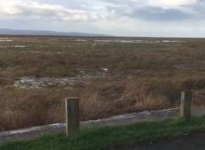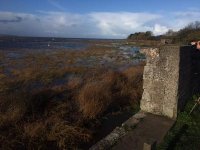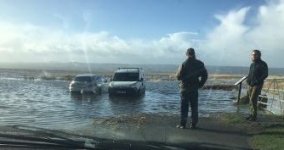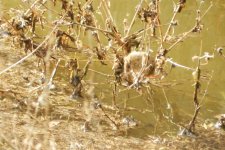wolfbirder
Well-known member
I love these High Tides at Parkgate, which when over 10 metres high and with a westerly wind to help, make it more likely to cover the whole marsh. Yesterday was an orthinological spectacle, as the wind, although mainly from the south, had a degree of westerly in it which certainly helped the peak 11am high tide to fully materialise. And it was ideal with Covid-19 in mind, as I didn't go closer than 5 metres from anyone else from the moment I shut my front door, to the moment I stepped back inside again ten hours later.
Parkgate is a quaint and plush old fishing village overlooking a large estuary across to Wales a few miles away, and at one end is the old Boathouse car park where people park up in their cars to watch the events unfold. So you can take shelter when its raining or when the biting winds get into your bones. Yesterday was not too cold, infact it was pleasantly sunny for long spells, but you could actually see the showers approaching from the SW, across the estuary. So my trusty old Punto was a useful refuge to enjoy warming flask tea and a mars bar.
I arrived at 9.30am yesterday, an hour and a half drive from Wolverhampton up the A41 and then M53, coming off at J4, where it is just a five-mile drive to Parkgate. There are various points you can watch the tide come in, not just from Parkgate. Nearby Heswall and Burton Point also provide good vantage points.
At first all is quite serene, skeins of Pink-footed Geese and some Canada's feed on small pools amongst Mallard. Being there around 1.5 hours before high tide allows you to watch as it develops. Through your scope, you can see that distantly, hundreds of Geese, Shelduck, Teal, Wigeon, Oystercatchers, Redshanks, and Dunlin and Knot are gradually being displaced and gathering on drier banks way out. Over the hour, they gradually get closer and closer. Large gulls and hundreds of Black-heads patrol as they increasingly become aware that the tide will flush out prey for them. A large group of over 40 Little Egrets and 3 Great Whites were omni-present and fairly unconcerned about things, whilst a few Grey Herons maintain their stations despite the incoming tide. Unsurprisingly, plenty of Crows, Rooks, and Jackdaws gather for the feast, but they can kill the beast, as the famous Eagles song went! Albeit the beast in this case is a tiny shrew or vole that is flushed out.
People come here for the raptors and owls mainly. It usually and consistently delivers the same species at these autumn high tides. A Sparrowhawk zipped low over the marsh just in front of the observers, and a Buzzard moved off back up the hill..... he didn't fancy getting his feet wet! A very photogenic female Kestrel often hovered just in front of us for most of the day.
Marsh Harriers have moved in here in recent years, and 5 birds were seen at one point, one plucked out an unfortunate Teal. A ring-tail Hen Harrier also showed periodically, and later in the afternoon a near full-adult male put in a brief appearance. A Peregrine also zipped through but surprisingly no Merlins were on show today. Though they could easily be missed. Thrillingly as always, a couple of Short-eared Owls were seen as the tide reached the wall, and I was fascinated as they flew around low over the water with 5 Herring Gulls in harrassing pursuit. At first I was concerned for the owls, fearing the nasty gulls would force them into the water, but after a while I realised that they weren't fussed by the close attention of the gulls, at all. The owls as usual, offered tremendous views down to a dozen metres, perched up and in flight as they looked for shrews and voles themselves.
Finally, as the tide reached the wall, hundreds of Skylarks, Meadow Pipits, and Linnets with a few Reed Buntings thrown in, reach the safety of the embankment, but then bizarrely turn around and fly back out over the water-filled marsh. They seem to prefer to land on the smallest pretruding bit of vegetation on the drenched estuary, rather than the paths and hedges along the dry embankment. Fascinating behaviour! Its as if they fail to understand that the marsh is temporarily under water and out-of-bounds for them.
Eventually, the tide starts to recede and things start to return to normal. Black-headed Gulls pick out any remaining or dead voles, and sometimes drop them back in the water again. Poor little things.
A harrier roost regularly evolves just prior to dusk, and then its time to head home, tired eyes and all. A Chinese takeaway awaits, to be washed down by a couple of cans. Write up the bird log in bed, and start snoring!
I enjoyed a great day, even though I have seen it twenty times before, it always stimulates and fulfills my ornithological senses.
A few crappy photos of the tide to finish with, showing the tide beforehand and at full tide..............
Parkgate is a quaint and plush old fishing village overlooking a large estuary across to Wales a few miles away, and at one end is the old Boathouse car park where people park up in their cars to watch the events unfold. So you can take shelter when its raining or when the biting winds get into your bones. Yesterday was not too cold, infact it was pleasantly sunny for long spells, but you could actually see the showers approaching from the SW, across the estuary. So my trusty old Punto was a useful refuge to enjoy warming flask tea and a mars bar.
I arrived at 9.30am yesterday, an hour and a half drive from Wolverhampton up the A41 and then M53, coming off at J4, where it is just a five-mile drive to Parkgate. There are various points you can watch the tide come in, not just from Parkgate. Nearby Heswall and Burton Point also provide good vantage points.
At first all is quite serene, skeins of Pink-footed Geese and some Canada's feed on small pools amongst Mallard. Being there around 1.5 hours before high tide allows you to watch as it develops. Through your scope, you can see that distantly, hundreds of Geese, Shelduck, Teal, Wigeon, Oystercatchers, Redshanks, and Dunlin and Knot are gradually being displaced and gathering on drier banks way out. Over the hour, they gradually get closer and closer. Large gulls and hundreds of Black-heads patrol as they increasingly become aware that the tide will flush out prey for them. A large group of over 40 Little Egrets and 3 Great Whites were omni-present and fairly unconcerned about things, whilst a few Grey Herons maintain their stations despite the incoming tide. Unsurprisingly, plenty of Crows, Rooks, and Jackdaws gather for the feast, but they can kill the beast, as the famous Eagles song went! Albeit the beast in this case is a tiny shrew or vole that is flushed out.
People come here for the raptors and owls mainly. It usually and consistently delivers the same species at these autumn high tides. A Sparrowhawk zipped low over the marsh just in front of the observers, and a Buzzard moved off back up the hill..... he didn't fancy getting his feet wet! A very photogenic female Kestrel often hovered just in front of us for most of the day.
Marsh Harriers have moved in here in recent years, and 5 birds were seen at one point, one plucked out an unfortunate Teal. A ring-tail Hen Harrier also showed periodically, and later in the afternoon a near full-adult male put in a brief appearance. A Peregrine also zipped through but surprisingly no Merlins were on show today. Though they could easily be missed. Thrillingly as always, a couple of Short-eared Owls were seen as the tide reached the wall, and I was fascinated as they flew around low over the water with 5 Herring Gulls in harrassing pursuit. At first I was concerned for the owls, fearing the nasty gulls would force them into the water, but after a while I realised that they weren't fussed by the close attention of the gulls, at all. The owls as usual, offered tremendous views down to a dozen metres, perched up and in flight as they looked for shrews and voles themselves.
Finally, as the tide reached the wall, hundreds of Skylarks, Meadow Pipits, and Linnets with a few Reed Buntings thrown in, reach the safety of the embankment, but then bizarrely turn around and fly back out over the water-filled marsh. They seem to prefer to land on the smallest pretruding bit of vegetation on the drenched estuary, rather than the paths and hedges along the dry embankment. Fascinating behaviour! Its as if they fail to understand that the marsh is temporarily under water and out-of-bounds for them.
Eventually, the tide starts to recede and things start to return to normal. Black-headed Gulls pick out any remaining or dead voles, and sometimes drop them back in the water again. Poor little things.
A harrier roost regularly evolves just prior to dusk, and then its time to head home, tired eyes and all. A Chinese takeaway awaits, to be washed down by a couple of cans. Write up the bird log in bed, and start snoring!
I enjoyed a great day, even though I have seen it twenty times before, it always stimulates and fulfills my ornithological senses.
A few crappy photos of the tide to finish with, showing the tide beforehand and at full tide..............
Attachments
Last edited:








